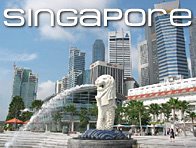

The Chao Phraya river is Bangkok’s lifeline: it was our preferred mode of transportation, especially in hot and humid weather. It is a long ribbon of brown/grayish water, with Bangkok on one side and Thonburi on the other. Most important historical sites are built on its banks. We were at Station 16, a 5 minute walk from our hotel. Piles of sandbags are always around the stations; frequently, you will find wooden planks positioned above ground so as to offer dry paths to pedestrians. Alas, on most, only one person can really fit and it becomes a game of wills when 2 or more people are trying to get through.
The river boats that are the workhorses of the Chao Praya are categorized as Yellow or Orange express lines, and White for local. Our fare was Bs. 10 apiece, the highest fare for going from Zone 2 to Zone 1. There are 3 zones in all, and they’ll be denoted on any river map.
You can hire a private boat that will take you for an hour’s ride, which we did, for Bs. 600 (US$14) and make stops at designated tourist spots. We did not want to make any stops, but we sat side by side toward the front of the vessel, and as we turned into one of the khlongs (canals), we caught glimpses of everyday life. Most remarkable to me was that regardless of how seedy the housing, every one had an abundance of potted flowers and plants. We went through a small floating market, and had a few vendors trying to interest us in knick knacks. A bit further, we stopped and bought bread to feed fish that magically surfaced in hundreds. It reminded me very much of Lake Mead, where we had a similar experience, feeding the fish popcorn.
As I suggested earlier, just get on one of these boats and take it as far as you can go. For 25 cents, you’ll get an overview of Bangkok and then you can decide where you’d like to further your explorations.
The best seat in the house is on your feet, posted at one of the openings toward the back, but take care not to stand where they reserve the area for monks. If it’s very crowded, you’ll be constantly elbowed by new passengers making their way to the front of the boat, and by the conductor/tress, who will tear your ticket in half with this circular metal coin holder which she seems to enjoy shaking to no end. If there is any irritant at all, it is the sound of the strident whistle you cannot escape, which is heard as a signal to the captain that he can proceed to the next stop. At times, two boats will get very close to each other, and their insurance against collision comes in the forms of used tires which they hang on the sides of the barges. Very clever indeed.
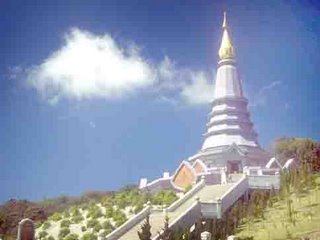 Doi Inthanon National Park covers the areas of Sanpatong District, Chomthong District, Mae Chaem District, Mae Wang District, and Toi Lor Sub-district of Chiang Mai Province within an approximate area of 482 square kilometers. The National Park consists of high mountains, including Doi Inthanon, which is the highest mountaintop in Thailand and the source of many rivers such as Ping River, where the Bhumipol Dam is situated and generating the electrical power. The National Park has beautiful natural scenery such as waterfalls, particularly Mae Ya Waterfall, which is one of the most beautiful waterfalls in Thailand.
Doi Inthanon National Park covers the areas of Sanpatong District, Chomthong District, Mae Chaem District, Mae Wang District, and Toi Lor Sub-district of Chiang Mai Province within an approximate area of 482 square kilometers. The National Park consists of high mountains, including Doi Inthanon, which is the highest mountaintop in Thailand and the source of many rivers such as Ping River, where the Bhumipol Dam is situated and generating the electrical power. The National Park has beautiful natural scenery such as waterfalls, particularly Mae Ya Waterfall, which is one of the most beautiful waterfalls in Thailand.
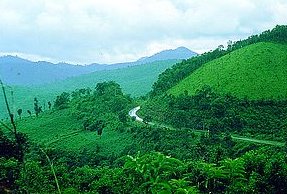 Since the National Park is located at 2,565 meters above the sea level, it has cold weather and high humidity throughout the year, particularly on the top of the National Park. In winter, the temperature at the National Park is below 0ac. And in summer, despite hot weather in central Chiang Mai and nearby districts, it is still freezing on the top of Doi Inthanon and tourists should be prepared with thick clothes.
Since the National Park is located at 2,565 meters above the sea level, it has cold weather and high humidity throughout the year, particularly on the top of the National Park. In winter, the temperature at the National Park is below 0ac. And in summer, despite hot weather in central Chiang Mai and nearby districts, it is still freezing on the top of Doi Inthanon and tourists should be prepared with thick clothes.
 Because of its broad altitudinal range and the cool climate of its upper reaches, the park supports the largest number of bird species of any site in Thailand. The Center for Wildlife Research at Mahidol University records a present total of 362 species and expects addition many at the summit are migrants from northern Asia. Species restricted to Doi Inthanon are Ashy-throated Warbler and an endemic race of the Green-tailed Sunbird; the park is the only site where the Chestnut-bellied Rock-Thrush and the Yellow-bellied Flower pecker are known to over summer and probably breed.
Because of its broad altitudinal range and the cool climate of its upper reaches, the park supports the largest number of bird species of any site in Thailand. The Center for Wildlife Research at Mahidol University records a present total of 362 species and expects addition many at the summit are migrants from northern Asia. Species restricted to Doi Inthanon are Ashy-throated Warbler and an endemic race of the Green-tailed Sunbird; the park is the only site where the Chestnut-bellied Rock-Thrush and the Yellow-bellied Flower pecker are known to over summer and probably breed.











 The materials for the bridge were brought from Java by the Imperial Japanese Army during their occupation of Thailand. In 1945 the bridge was bombed several times and was only rebuilt after the war - the curved portions of the bridge are original. The first version of the bridge, completed in February 1943, was all wood. In April of the same year a second bridge of steel was constructed.
It's estimated 16,000 prisoners of war (POWs) died building the Death Railway to Myanmar, of which the bridge was only a small part. The objective of the railway was to secure an alternative supply route for the Japanese conquest of Burma and other Asian countries to the west. Construction of the railway began on 16 September 1942 at existing terminals in Thanbyuzayat, Myanmar and Nong Pladuk, Thailand. Japanese engineers at the time estimated that it would take five years to link Thailand and Myanmar by rail, but the Japanese army forced the POWs to complete the 415km, 1m-gauge railway (of which roughly two-thirds ran through Thailand) in 16 months. Much of the railway was built in difficult terrain that required high bridges and deep mountain cuttings. The rails were finally joined 37km south of Three Pagodas Pass; a Japanese brothel train inaugurated the line. The River Khwae Bridge was in use for 20 months before the Allies bombed it in 1945. Only one POW is known to have escaped, a Briton who took refuge among pro-British Karen guerrillas.
The materials for the bridge were brought from Java by the Imperial Japanese Army during their occupation of Thailand. In 1945 the bridge was bombed several times and was only rebuilt after the war - the curved portions of the bridge are original. The first version of the bridge, completed in February 1943, was all wood. In April of the same year a second bridge of steel was constructed.
It's estimated 16,000 prisoners of war (POWs) died building the Death Railway to Myanmar, of which the bridge was only a small part. The objective of the railway was to secure an alternative supply route for the Japanese conquest of Burma and other Asian countries to the west. Construction of the railway began on 16 September 1942 at existing terminals in Thanbyuzayat, Myanmar and Nong Pladuk, Thailand. Japanese engineers at the time estimated that it would take five years to link Thailand and Myanmar by rail, but the Japanese army forced the POWs to complete the 415km, 1m-gauge railway (of which roughly two-thirds ran through Thailand) in 16 months. Much of the railway was built in difficult terrain that required high bridges and deep mountain cuttings. The rails were finally joined 37km south of Three Pagodas Pass; a Japanese brothel train inaugurated the line. The River Khwae Bridge was in use for 20 months before the Allies bombed it in 1945. Only one POW is known to have escaped, a Briton who took refuge among pro-British Karen guerrillas.
 Train enthusiasts may enjoy the railway museum in front of the bridge, with engines used during WWII on display. Every year during the first week of December there is a nightly sound-and-light show at the bridge, commemorating the Allied attack on the Death Railway in 1945. It's a big scene, with the sounds of bombers and explosions, fantastic bursts of light and more. The town gets a lot of Thai tourists during this week, so book early if you want to witness this spectacle.
Train enthusiasts may enjoy the railway museum in front of the bridge, with engines used during WWII on display. Every year during the first week of December there is a nightly sound-and-light show at the bridge, commemorating the Allied attack on the Death Railway in 1945. It's a big scene, with the sounds of bombers and explosions, fantastic bursts of light and more. The town gets a lot of Thai tourists during this week, so book early if you want to witness this spectacle.
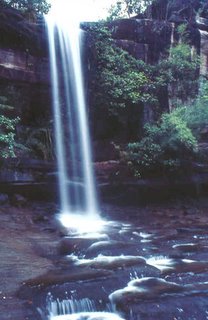
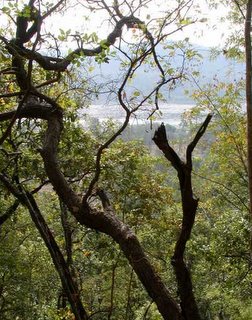
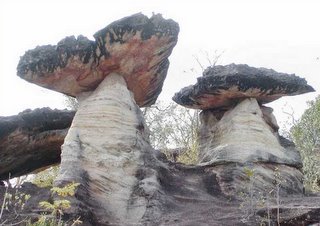 The park located in Ubon Ratchatani province, covers Amphur Khong Jiam, Sri Muang Mai and Pho Sai. The 340km2 park is a wide variety of interesting scenery and activities. The fascinating aspect is the Mekhong river which serves as a long natural border between the park and Loas providing some excellent views. The area has a considerable historical and natural value and was requested to become a national park on the 31st December 1991 as the 74th national park of Thailand.
The park has a monsoonal climate with three distinct season; The rain (June-September), the cold (October-February) and the dry season (March-May). The park can be visited all year but be prepared for the chilly nights in the cold season and the occasional heavy thunderstorms in the rain season.
The park covers by Dipterocarp forest with Shorea obtusa, Shorea siamensis, Dipterocarpus obtusifollus are dominant species and some beautiful flowers. Beyond, there are some dry evergreen forests near streams.
It is also wildlife habitats for example Siamese hare, barking deer, civet, palm civet. And we can see wild pig and serow, which moved from Laos in summer
The general topography of the park are undulating plains and highlands, and is part of the Phannom Dongrak mountain range. Rock pillars and rock formations are characteristics park. Sandstone is the most common rock type found. The Mekhong river is the ends of the many streams of the park.
The park has a monsoon climate with three seasons: rainy season (June to October), cool season (October to February) and the dry and hot season (February to June).
The park is covered by Dipterocarp forest with Shorea obtusa, Shorea siamensis, Dipterocarpus obtusifollus and some beautiful flowers. There are also some dry evergreen forests near the streams.
The park located in Ubon Ratchatani province, covers Amphur Khong Jiam, Sri Muang Mai and Pho Sai. The 340km2 park is a wide variety of interesting scenery and activities. The fascinating aspect is the Mekhong river which serves as a long natural border between the park and Loas providing some excellent views. The area has a considerable historical and natural value and was requested to become a national park on the 31st December 1991 as the 74th national park of Thailand.
The park has a monsoonal climate with three distinct season; The rain (June-September), the cold (October-February) and the dry season (March-May). The park can be visited all year but be prepared for the chilly nights in the cold season and the occasional heavy thunderstorms in the rain season.
The park covers by Dipterocarp forest with Shorea obtusa, Shorea siamensis, Dipterocarpus obtusifollus are dominant species and some beautiful flowers. Beyond, there are some dry evergreen forests near streams.
It is also wildlife habitats for example Siamese hare, barking deer, civet, palm civet. And we can see wild pig and serow, which moved from Laos in summer
The general topography of the park are undulating plains and highlands, and is part of the Phannom Dongrak mountain range. Rock pillars and rock formations are characteristics park. Sandstone is the most common rock type found. The Mekhong river is the ends of the many streams of the park.
The park has a monsoon climate with three seasons: rainy season (June to October), cool season (October to February) and the dry and hot season (February to June).
The park is covered by Dipterocarp forest with Shorea obtusa, Shorea siamensis, Dipterocarpus obtusifollus and some beautiful flowers. There are also some dry evergreen forests near the streams.
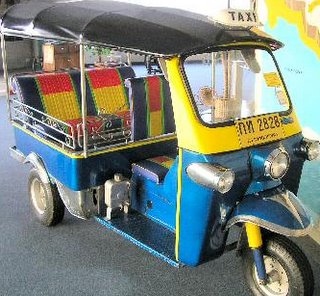


 The largest and most beautiful waterfall in the western region, Erawan Waterfall is on the bank of Kwai Yai River in Khao Salop (Erawan) National Park. It is about 2,000 metres tall divided into 7 levels. The atmosphere in this always-verdant national park is serene, peaceful and rich with innumerable plant and flower species, perfectly conducive to sight-seeing and relaxation.
The largest and most beautiful waterfall in the western region, Erawan Waterfall is on the bank of Kwai Yai River in Khao Salop (Erawan) National Park. It is about 2,000 metres tall divided into 7 levels. The atmosphere in this always-verdant national park is serene, peaceful and rich with innumerable plant and flower species, perfectly conducive to sight-seeing and relaxation.
 Erawan Waterfalls are the focal point of the Erawan National Park. This is an exquisite park, very pretty, and very popular with locals and foreigners alike. The waterfalls are equally exquisite. There are seven tiers of waterfalls, each feeding lovely, freshwater pools that you can swim in. A series of tracks lead you to the various falls across wooden footbridges - quite an experience in their own right! The waterfalls can get a bit crowded as they are so popular, so if you are looking for a more solitary experience, you should perhaps look elsewhere. A number of stalls provide staples like grilled chicken and rice along the way, and there is often very much of a carnival atmosphere about the place, especially in April during the Songkran Festival. A visit here will take the day – you should bear this in mind if you have limited time.
Erawan Waterfalls are the focal point of the Erawan National Park. This is an exquisite park, very pretty, and very popular with locals and foreigners alike. The waterfalls are equally exquisite. There are seven tiers of waterfalls, each feeding lovely, freshwater pools that you can swim in. A series of tracks lead you to the various falls across wooden footbridges - quite an experience in their own right! The waterfalls can get a bit crowded as they are so popular, so if you are looking for a more solitary experience, you should perhaps look elsewhere. A number of stalls provide staples like grilled chicken and rice along the way, and there is often very much of a carnival atmosphere about the place, especially in April during the Songkran Festival. A visit here will take the day – you should bear this in mind if you have limited time.
 There are two entrances to the park. On the west, a road comes from Sai Yok National Park. On the south,highway 323 comes from Kanjanaburi.
There are two entrances to the park. On the west, a road comes from Sai Yok National Park. On the south,highway 323 comes from Kanjanaburi.
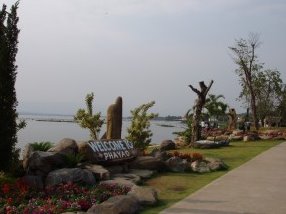
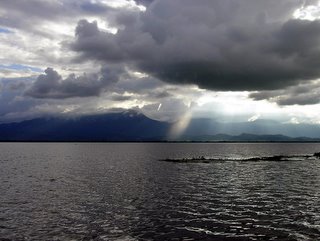 This natural lake having clear and clean water occupies a space of 12,831 rais. It is beautiful and a breeding source for fresh water fishes, especially the freshwater pla buek catfish. There are a lot of food shops locted along the bank suitable for dining and relaxing in the evening in during the sunset.
A large, permanent, freshwater lake (1,980 ha), fringed by approximately 3,000 ha of rice paddy to the south and west and with a marshy area and some old oxbows (c.300 ha) at the northern end where the Nam Mae Ing empties into the lake. There is also some inflow from the Mae Tam which empties into the lake from the south. The eastern shore of the lake is largely built-up, and the town of Phayao lies near the southeast corner. The lake empties to the east, via the Nam Mae lag, into the Mekong. The water level is controlled by a sluice gate and a spillway; the mean depth is 1.7m, and the pH varies from 6.0-9.1. Kwan Phayao is one of the largest semi-natural wetlands in northern Thailand.
Thirty-six species of aquatic plants have been recorded. Najas graminea and Ceratophyllum demersum are the predominant submerged plants. There is also much Salvinia cucullata, Eichhornia crassipes, Nelumbo nucifera, and some Scirpus grossus. Adjacent areas are almost entirely cultivated (mainly rice paddy with some maize, groundnuts and tobacco).
The lake is in public ownership, but the adjacent shoreline is mainly privately owned. Surrounding areas are privately owned farmland, much of which is leased to tenant farmers.
This natural lake having clear and clean water occupies a space of 12,831 rais. It is beautiful and a breeding source for fresh water fishes, especially the freshwater pla buek catfish. There are a lot of food shops locted along the bank suitable for dining and relaxing in the evening in during the sunset.
A large, permanent, freshwater lake (1,980 ha), fringed by approximately 3,000 ha of rice paddy to the south and west and with a marshy area and some old oxbows (c.300 ha) at the northern end where the Nam Mae Ing empties into the lake. There is also some inflow from the Mae Tam which empties into the lake from the south. The eastern shore of the lake is largely built-up, and the town of Phayao lies near the southeast corner. The lake empties to the east, via the Nam Mae lag, into the Mekong. The water level is controlled by a sluice gate and a spillway; the mean depth is 1.7m, and the pH varies from 6.0-9.1. Kwan Phayao is one of the largest semi-natural wetlands in northern Thailand.
Thirty-six species of aquatic plants have been recorded. Najas graminea and Ceratophyllum demersum are the predominant submerged plants. There is also much Salvinia cucullata, Eichhornia crassipes, Nelumbo nucifera, and some Scirpus grossus. Adjacent areas are almost entirely cultivated (mainly rice paddy with some maize, groundnuts and tobacco).
The lake is in public ownership, but the adjacent shoreline is mainly privately owned. Surrounding areas are privately owned farmland, much of which is leased to tenant farmers.
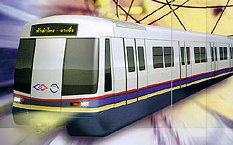 The MRT subway, Bangkok's second major mass transit system is on track for a test run on April 13, 2004, in preparation for an official opening on August 12, 2004, Her Majesty the Queen's Birthday.
The subway rail system will run from the city's main railway station, Hua Lamphong, under two major thoroughfares linking the Queen Sirikit National Convention Centre with several more hotels, shopping centres and business districts. Its route is 20 kilometres long with 17 stations and four interchange stations that will connect to the Skytrain. More interchange stations will come on stream after line extensions to the Skytrain are completed.
The subway is one of a number of infrastructure and transportation development projects underway in Bangkok and nationwide. Others include extension of the highway network in the provinces, improved seaport facilities and construction of the New Bangkok International Airport (Suvarnabhumi Airport).
The foundation stone of the subway was laid at Hua Lamphong train station on November 19, 1996, and construction began in 1997. Private investors on a 25-year concession from the government’s Mass Transit Authority of Thailand (MRTA) will operate it.
Safety has been a primary consideration in the construction of the subway. Many have questioned building of a subway system in a city with porous soil, wasn’t there a risk of flooding. Don’t worry, all the entrances and shafts to the subway are built above the 200-year flood level for Bangkok (1.2-1.5 meter above ground level). If the water goes over the 200 year flood level, all openings have "stop block" doors that close to seal the openings.
The MRT subway, Bangkok's second major mass transit system is on track for a test run on April 13, 2004, in preparation for an official opening on August 12, 2004, Her Majesty the Queen's Birthday.
The subway rail system will run from the city's main railway station, Hua Lamphong, under two major thoroughfares linking the Queen Sirikit National Convention Centre with several more hotels, shopping centres and business districts. Its route is 20 kilometres long with 17 stations and four interchange stations that will connect to the Skytrain. More interchange stations will come on stream after line extensions to the Skytrain are completed.
The subway is one of a number of infrastructure and transportation development projects underway in Bangkok and nationwide. Others include extension of the highway network in the provinces, improved seaport facilities and construction of the New Bangkok International Airport (Suvarnabhumi Airport).
The foundation stone of the subway was laid at Hua Lamphong train station on November 19, 1996, and construction began in 1997. Private investors on a 25-year concession from the government’s Mass Transit Authority of Thailand (MRTA) will operate it.
Safety has been a primary consideration in the construction of the subway. Many have questioned building of a subway system in a city with porous soil, wasn’t there a risk of flooding. Don’t worry, all the entrances and shafts to the subway are built above the 200-year flood level for Bangkok (1.2-1.5 meter above ground level). If the water goes over the 200 year flood level, all openings have "stop block" doors that close to seal the openings.
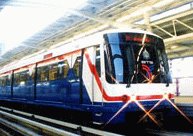 The BTS Skytrain is the safest, most comfortable and convenient way to get around Bangkok. In service since December 5, 1999, it has transformed the face of public transportation in the Thai capital, for the first time offering both residents and visitors a comfortable ride through central Bangkok - lifting commuters above the chronic congestion, noise and pollution of the streets below.
Our modern electrified trains transport Bangkok's commuters in wide air-conditioned cars, saving them time with quick, reliable service. The BTS SkyTrain's high-capacity operating system ensures almost no breakdowns and a virtual 100% punctuality. Each train can carry over 1,000 passengers while a similar number of people would use 800 cars, making the BTS Skytrain the most environmentally friendly mass transit system in Thailand.
Currently there are two routes, the Sukhumvit Line and the Silom Line. They cover much of the central city and its many commercial, residential and tourist areas, with extensions planned to outlying areas. The trains run daily between 6:00 am and 12:00 midnight with frequent service throughout the day, increased during rush hours. The fare is based on the distance traveled.
The BTS is eager to help promote tourism in Bangkok and assist foreign visitors who use our system. At the BTS Tourist Information Center visitors can get useful information on Bangkok’s variety of attractions and assistance in traveling around town. Our services include offering boat tickets for the Chao Praya River Tour, and internet services.
Kick off a great journey around Bangkok with the Skytrain - the city’s safest, most convenient, and most reliable transport. Take it to see Bangkok's many attractions, including some of its best shopping places and cultural sights. To make your visit even more memorable, we offer a river tour using the Chao Praya Express Boat Company to visit the magnificent historical places along the Chao Praya River.
Find out just how easy and convenient it is to use the BTS SkyTrain to see Bangkok's many commercial, tourist, shopping and cultural sights with our one-day travel programs.
The BTS Skytrain is the safest, most comfortable and convenient way to get around Bangkok. In service since December 5, 1999, it has transformed the face of public transportation in the Thai capital, for the first time offering both residents and visitors a comfortable ride through central Bangkok - lifting commuters above the chronic congestion, noise and pollution of the streets below.
Our modern electrified trains transport Bangkok's commuters in wide air-conditioned cars, saving them time with quick, reliable service. The BTS SkyTrain's high-capacity operating system ensures almost no breakdowns and a virtual 100% punctuality. Each train can carry over 1,000 passengers while a similar number of people would use 800 cars, making the BTS Skytrain the most environmentally friendly mass transit system in Thailand.
Currently there are two routes, the Sukhumvit Line and the Silom Line. They cover much of the central city and its many commercial, residential and tourist areas, with extensions planned to outlying areas. The trains run daily between 6:00 am and 12:00 midnight with frequent service throughout the day, increased during rush hours. The fare is based on the distance traveled.
The BTS is eager to help promote tourism in Bangkok and assist foreign visitors who use our system. At the BTS Tourist Information Center visitors can get useful information on Bangkok’s variety of attractions and assistance in traveling around town. Our services include offering boat tickets for the Chao Praya River Tour, and internet services.
Kick off a great journey around Bangkok with the Skytrain - the city’s safest, most convenient, and most reliable transport. Take it to see Bangkok's many attractions, including some of its best shopping places and cultural sights. To make your visit even more memorable, we offer a river tour using the Chao Praya Express Boat Company to visit the magnificent historical places along the Chao Praya River.
Find out just how easy and convenient it is to use the BTS SkyTrain to see Bangkok's many commercial, tourist, shopping and cultural sights with our one-day travel programs.
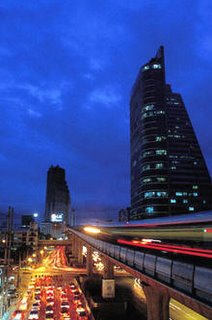
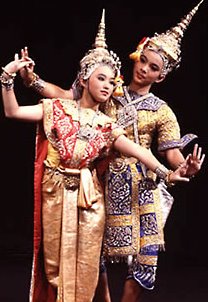
 Thai Dancing:
The Thai Dance is a graceful and interpretative performance. It has played an indispensable part of Thai life from historical times to the present day. Thai dance is closely intertwined with the beliefs, traditions and customs of Thailand and is therefore important to the lives of the people. It has been kept alive through royal patronage in a continuous line of succession through the Sukhothai, Ayutthaya and Rattanakosin periods.
Thai dancing may be divided into two major styles: folk dance ('rabam phun muang') and classical dance ('natasin'). Each of the four regions of Thailand has its own folk dances that are usually associated with agricultural and social activities, such as rice planting, harvesting, festivals, and religious celebrations. Basically, northern folk dances are elegant and graceful while the dances of the South and Northeast are more active and fun-filled, but still retain the fundamental grace of Thai dancing in general. Central and eastern dances are clearly linked to the agrarian lifestyles of the people.
From the basic movements of folk dances, classical Thai dance further refined the elaborate hand gestures, arm and leg movements that are able to captivate audiences to this day.
Clasical Thai Dancing:
The history of Thai drama has generally been treated as a part of the study of Thai literature, culture and customs. The earliest literary references to Clasical Thai dancing appeared in the stone inscription of Phor Khun Ramkhamhaeng, the third king of the Sukhothai Kingdom.
Thai Dancing:
The Thai Dance is a graceful and interpretative performance. It has played an indispensable part of Thai life from historical times to the present day. Thai dance is closely intertwined with the beliefs, traditions and customs of Thailand and is therefore important to the lives of the people. It has been kept alive through royal patronage in a continuous line of succession through the Sukhothai, Ayutthaya and Rattanakosin periods.
Thai dancing may be divided into two major styles: folk dance ('rabam phun muang') and classical dance ('natasin'). Each of the four regions of Thailand has its own folk dances that are usually associated with agricultural and social activities, such as rice planting, harvesting, festivals, and religious celebrations. Basically, northern folk dances are elegant and graceful while the dances of the South and Northeast are more active and fun-filled, but still retain the fundamental grace of Thai dancing in general. Central and eastern dances are clearly linked to the agrarian lifestyles of the people.
From the basic movements of folk dances, classical Thai dance further refined the elaborate hand gestures, arm and leg movements that are able to captivate audiences to this day.
Clasical Thai Dancing:
The history of Thai drama has generally been treated as a part of the study of Thai literature, culture and customs. The earliest literary references to Clasical Thai dancing appeared in the stone inscription of Phor Khun Ramkhamhaeng, the third king of the Sukhothai Kingdom.
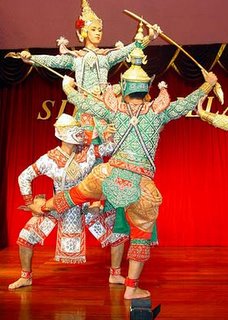
 It's in the early morning that the three floating markets of Damnoen Saduak are seen at their best, so whether you hire a boat with friends or join an organised trip, try to get out on the water early. Even by 8am, the markets are already buzzing with life, but you will still be able to navigate the canals and channels in your own time and marvel at the abundance of fruit, vegetables and other foodstuffs and goods on offer.
Boat-to-boat trading like this is becoming a rarity in Thailand, but it hardly feels like a dying way of life when you're in the thick of the action. The trading among the 100s of straw-hatted vendors is fast-paced and competitive, as they paddle their boats up and down the narrow waterways in search of customers. It makes for a memorable morning out on the water - and all the delicious food on offer is sure to get your tastebuds going in time for an early lunch!
The Damnoen Saduak Floating Market is located Located 80km (50 miles) southwest of Bangkok, Damnoen Saduak Floating Market is a daily riot of colour and noise. Farmers and smallholders from the surrounding hills turn up each morning to sell and exchange fruit and vegetables from their heavily-laden barges, as they sail up and down the canals amongst the orchards and vineyards. The Damnoen Saduak Floating Market is a very attractive place for tourists to see the old style and traditional way of selling and buying fruits, vegetables, etc., from small boats. Tourists will also see traditional Thai houses, the way they live and travel by boats, and please try riding on a small boat to experience the floating market and to see more. This is a worthwhile trip.
It's in the early morning that the three floating markets of Damnoen Saduak are seen at their best, so whether you hire a boat with friends or join an organised trip, try to get out on the water early. Even by 8am, the markets are already buzzing with life, but you will still be able to navigate the canals and channels in your own time and marvel at the abundance of fruit, vegetables and other foodstuffs and goods on offer.
Boat-to-boat trading like this is becoming a rarity in Thailand, but it hardly feels like a dying way of life when you're in the thick of the action. The trading among the 100s of straw-hatted vendors is fast-paced and competitive, as they paddle their boats up and down the narrow waterways in search of customers. It makes for a memorable morning out on the water - and all the delicious food on offer is sure to get your tastebuds going in time for an early lunch!
The Damnoen Saduak Floating Market is located Located 80km (50 miles) southwest of Bangkok, Damnoen Saduak Floating Market is a daily riot of colour and noise. Farmers and smallholders from the surrounding hills turn up each morning to sell and exchange fruit and vegetables from their heavily-laden barges, as they sail up and down the canals amongst the orchards and vineyards. The Damnoen Saduak Floating Market is a very attractive place for tourists to see the old style and traditional way of selling and buying fruits, vegetables, etc., from small boats. Tourists will also see traditional Thai houses, the way they live and travel by boats, and please try riding on a small boat to experience the floating market and to see more. This is a worthwhile trip.
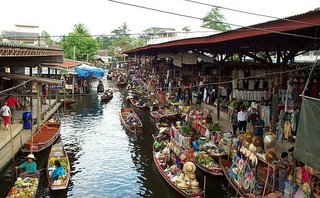
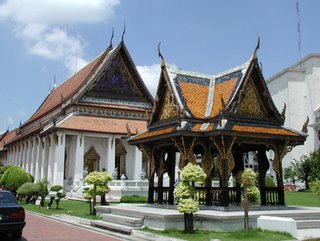
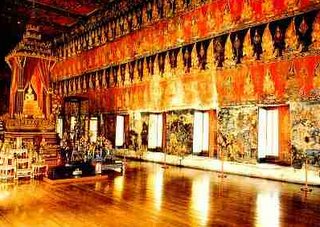 The collections of the National Museum, Bangkok are national cultural heritage with the emphasis on art, archeological and cultural objects which are dated from as early as prehistory up to presentday. Three main galleries are :
The Gallery of Thai History located at Sivamokkha - phiman hall with the prehistoric gallery at the rear part of the building.
History of Art and Archeological Collections are presented in two buildings : Dvaravati, Srivijaya and Lopburi in south wing ; and Lanna, Sukhothai, Ayutthaya and Rattanakosin are in the north wing.
For the galleries in the old palace buildings, variety of minor arts and ethnological collections are exhibited such as gold treasure, enamel wares, mother-of-pearl inlay, musical instruments, wood carving, entertainment articles, textiles, ceramics, royal regalia, palanquins, old weapons, and stone inscriptions, etc. Royal Cremation ceremonial exhibits and chariots are housed in the cremation chariot hall.
The National Museum, Bangkok also has a monumental value in itself as a Palace to the Front. Many buildings are displayed in original purpose such as Buddhaisawan Chapel where the Buddha Sihing was enshrined. European and Chinese furnitures are shown in Issaretra-chanusorn, or King Pin Klao resident. Tamnak Daeng or the Red House, Sala Samarn - Mukhamat, and other pavillions are examples of Thai architecture.
The collections of the National Museum, Bangkok are national cultural heritage with the emphasis on art, archeological and cultural objects which are dated from as early as prehistory up to presentday. Three main galleries are :
The Gallery of Thai History located at Sivamokkha - phiman hall with the prehistoric gallery at the rear part of the building.
History of Art and Archeological Collections are presented in two buildings : Dvaravati, Srivijaya and Lopburi in south wing ; and Lanna, Sukhothai, Ayutthaya and Rattanakosin are in the north wing.
For the galleries in the old palace buildings, variety of minor arts and ethnological collections are exhibited such as gold treasure, enamel wares, mother-of-pearl inlay, musical instruments, wood carving, entertainment articles, textiles, ceramics, royal regalia, palanquins, old weapons, and stone inscriptions, etc. Royal Cremation ceremonial exhibits and chariots are housed in the cremation chariot hall.
The National Museum, Bangkok also has a monumental value in itself as a Palace to the Front. Many buildings are displayed in original purpose such as Buddhaisawan Chapel where the Buddha Sihing was enshrined. European and Chinese furnitures are shown in Issaretra-chanusorn, or King Pin Klao resident. Tamnak Daeng or the Red House, Sala Samarn - Mukhamat, and other pavillions are examples of Thai architecture.
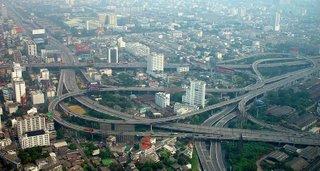 - The Baiyoke Tower was opened in 1998.
- This building is 309 metres tall or about the height of 182 people standing one on top of the other.
- There are 1,740 windowpanes in the building. About the same number of windowpanes can be used for over 200 townhouses.
- The area inside this building is about 30 football fields.
- There are altogether 2,060 steps from the bottom to the top. It takes more than one hour to reach the top.
The Bangkok Observation is located at the top of Baiyoke Sky, the tallest tower in the Kingdom of Thailand.
- 76th Floor: Sky Buffet
- 77th Floor: Observation Deck
- 84th Floor: Rovolving Roof Deck
- The Baiyoke Tower was opened in 1998.
- This building is 309 metres tall or about the height of 182 people standing one on top of the other.
- There are 1,740 windowpanes in the building. About the same number of windowpanes can be used for over 200 townhouses.
- The area inside this building is about 30 football fields.
- There are altogether 2,060 steps from the bottom to the top. It takes more than one hour to reach the top.
The Bangkok Observation is located at the top of Baiyoke Sky, the tallest tower in the Kingdom of Thailand.
- 76th Floor: Sky Buffet
- 77th Floor: Observation Deck
- 84th Floor: Rovolving Roof Deck

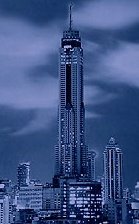
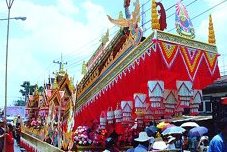 Traditionally, the rocket festival is the sixth Lunar month ceremony that Lao people have conducted for many generation(s). It is a very important event that we could not abandon since the early period of time. It is also the important symbol of unity and friendship used to fight against dry weather and to request rain.
Eventhough, belief in the rain god is less now than in former times, the Lao still respect this tradition and continue to prepare the rocket festival as one of the most significant activities that takes place before of the season of rice cultivation. In addition to the preparation of rockets, there are some Buddhist ceremonies such as waterblessing rituals that the senior monks perform at the same event.
The Rocket festival is the only annual chance the farmers have to request rain from the god called Phaya Thaen. Because of the strong belief held since ancient times, when the land was dry and farmers did not have enough water for rice production. So the rocket festival were instituted. It is the one means for human beings to communicate symbolically with the god to request rain.
The rocket launching itself is competitive, with prizes for the best explosion, greatest distance, etc. The secrets of rocket making have been passed down over the generations and refined into sophisticated, multi-chambered wonders of pre-scientific technology. Some of these things are four or five meters long, and fly a kilometer or more, or explode at their apogee into a spectacular and colorful fireball.
As if this wasn’t enough, there are countless other activities (as with any country fair) including live music, dancing and other contests.
Though countless villages observe the celebration, on various dates and the best organized is held in Yasothorn Province. This year the three-day blowout runs from May 10-12.
Traditionally, the rocket festival is the sixth Lunar month ceremony that Lao people have conducted for many generation(s). It is a very important event that we could not abandon since the early period of time. It is also the important symbol of unity and friendship used to fight against dry weather and to request rain.
Eventhough, belief in the rain god is less now than in former times, the Lao still respect this tradition and continue to prepare the rocket festival as one of the most significant activities that takes place before of the season of rice cultivation. In addition to the preparation of rockets, there are some Buddhist ceremonies such as waterblessing rituals that the senior monks perform at the same event.
The Rocket festival is the only annual chance the farmers have to request rain from the god called Phaya Thaen. Because of the strong belief held since ancient times, when the land was dry and farmers did not have enough water for rice production. So the rocket festival were instituted. It is the one means for human beings to communicate symbolically with the god to request rain.
The rocket launching itself is competitive, with prizes for the best explosion, greatest distance, etc. The secrets of rocket making have been passed down over the generations and refined into sophisticated, multi-chambered wonders of pre-scientific technology. Some of these things are four or five meters long, and fly a kilometer or more, or explode at their apogee into a spectacular and colorful fireball.
As if this wasn’t enough, there are countless other activities (as with any country fair) including live music, dancing and other contests.
Though countless villages observe the celebration, on various dates and the best organized is held in Yasothorn Province. This year the three-day blowout runs from May 10-12.
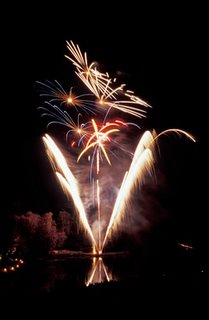
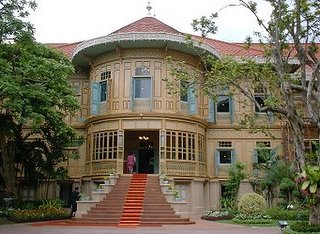 Vimanmek Mansion is the largest residence in Dusit Garden. Its elaborate architectural style reflects a western influence. The building has two right-angled wings. Each wing is 60 metres long and 20 metres high. It is a three-storey building except for the part where the King resided, which is octagonal and has four-storeys. The ground floor is brick and cement while the upper floors are built of golden teakwood planks. There are altogether 31 exhibition rooms, some of which maintain the atmosphere of the past, especially the bedrooms, the Audience Chamber and the bathrooms. Some rooms house exhibitions of art works, for example, there is a silverware display room, a ceramic display room, a glassware display room and an ivory display room.
Besides Vimanmek Mansion and the Amporn Satarn Mansion in the compound of Dusit Garden or Dusit Palace (as it was later renamed by King Rama V), King Rama V allocated plots of land for the construction of residences for his Queens, consorts, sisters, daughters, and his other wives. He also named gardens, canals, gates and roads after the names of ancient Chinese porcelain commonly called “Khrueng Kim Tung”, which were very popular at the time. For example, the residence that belonged to Her Majesty Queen Srisawarindhira was named Suan Hong Residence (Swan Garden Residence). Now these residences, which are no longer used by the Royal Family and located north of Vimanmek Mansion, have been turned into museum buildings and a hall for royal coaches to be shown to the general public.
Vimanmek Mansion is the largest residence in Dusit Garden. Its elaborate architectural style reflects a western influence. The building has two right-angled wings. Each wing is 60 metres long and 20 metres high. It is a three-storey building except for the part where the King resided, which is octagonal and has four-storeys. The ground floor is brick and cement while the upper floors are built of golden teakwood planks. There are altogether 31 exhibition rooms, some of which maintain the atmosphere of the past, especially the bedrooms, the Audience Chamber and the bathrooms. Some rooms house exhibitions of art works, for example, there is a silverware display room, a ceramic display room, a glassware display room and an ivory display room.
Besides Vimanmek Mansion and the Amporn Satarn Mansion in the compound of Dusit Garden or Dusit Palace (as it was later renamed by King Rama V), King Rama V allocated plots of land for the construction of residences for his Queens, consorts, sisters, daughters, and his other wives. He also named gardens, canals, gates and roads after the names of ancient Chinese porcelain commonly called “Khrueng Kim Tung”, which were very popular at the time. For example, the residence that belonged to Her Majesty Queen Srisawarindhira was named Suan Hong Residence (Swan Garden Residence). Now these residences, which are no longer used by the Royal Family and located north of Vimanmek Mansion, have been turned into museum buildings and a hall for royal coaches to be shown to the general public.
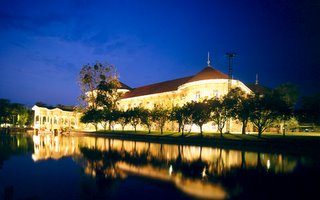
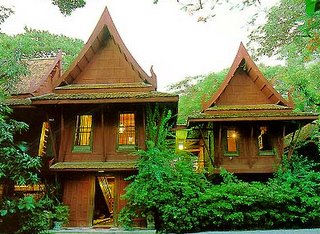 Despite the name, Jim Thompson's House is one of the best-preserved examples of the traditional Thai house in the city. Once home to the American silk entrepreneur Jim Thompson, this remarkable house-cum-museum accommodates Thompson's vast collection of antiques and artworks from all over the Southeast Asian region. Notable items include priceless examples of blue and white Ming porcelain and 19th century jataka paintings, which cover the walls of the rooms. Don't miss the headless Buddha figure in the garden, which dates from the 6th century. This early Dvaravati image is one of the oldest surviving Buddha statues in the world.
Despite the name, Jim Thompson's House is one of the best-preserved examples of the traditional Thai house in the city. Once home to the American silk entrepreneur Jim Thompson, this remarkable house-cum-museum accommodates Thompson's vast collection of antiques and artworks from all over the Southeast Asian region. Notable items include priceless examples of blue and white Ming porcelain and 19th century jataka paintings, which cover the walls of the rooms. Don't miss the headless Buddha figure in the garden, which dates from the 6th century. This early Dvaravati image is one of the oldest surviving Buddha statues in the world.
 Perhaps even more fascinating than the house itself is the tale of the mysterious owner, American Jim Thompson. A former member of the US Office of Strategic Services (OSS), the forerunner of the CIA, Thompson revived the flagging silk weaving industry at the end of the Second World War. His marketing skills helped turn the fortunes of the ailing Thai silk industry around, and Jim Thompson is to this day regarded as the very finest brand of Thai silk. As his business grew, Jim Thompson became a well-known Bangkok socialite, dedicated to reviving Thai crafts and arts. Much of his art collection is still on display at his Ayutthayan house in Bangkok's Rama I Road area.
Jim Thompson disappeared under mysterious circumstances whilst on a walk in the Cameron Highlands in Malaysia in 1967. Many theories have been put forward to explain his disappearance but the truth remains a mystery. Suggestions of a conspiracy involving his CIA connections have been proposed in explanation, but so too have jungle tigers, heart attacks and Communist insurgents.
Perhaps even more fascinating than the house itself is the tale of the mysterious owner, American Jim Thompson. A former member of the US Office of Strategic Services (OSS), the forerunner of the CIA, Thompson revived the flagging silk weaving industry at the end of the Second World War. His marketing skills helped turn the fortunes of the ailing Thai silk industry around, and Jim Thompson is to this day regarded as the very finest brand of Thai silk. As his business grew, Jim Thompson became a well-known Bangkok socialite, dedicated to reviving Thai crafts and arts. Much of his art collection is still on display at his Ayutthayan house in Bangkok's Rama I Road area.
Jim Thompson disappeared under mysterious circumstances whilst on a walk in the Cameron Highlands in Malaysia in 1967. Many theories have been put forward to explain his disappearance but the truth remains a mystery. Suggestions of a conspiracy involving his CIA connections have been proposed in explanation, but so too have jungle tigers, heart attacks and Communist insurgents.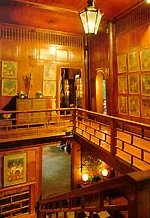
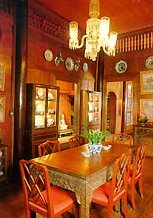 LOCATION: 6 Soi Kasemsan 2, Rama I Road, Bangkok. Tel: 216-7368, 215-0122
GETTING THERE: Jim Thompson's House is at the end of a small lane opposite the National Stadium. You can either get off the sky train at the stadium or nearby Siam Square.
OPENING HOURS: Open every day at 9 a.m. The last tour begins at 4.30 p.m.
ADMISSION: 100 baht
LOCATION: 6 Soi Kasemsan 2, Rama I Road, Bangkok. Tel: 216-7368, 215-0122
GETTING THERE: Jim Thompson's House is at the end of a small lane opposite the National Stadium. You can either get off the sky train at the stadium or nearby Siam Square.
OPENING HOURS: Open every day at 9 a.m. The last tour begins at 4.30 p.m.
ADMISSION: 100 baht


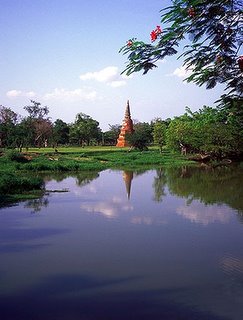
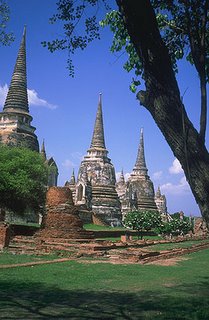

 The Chao Phraya river is Bangkok’s lifeline: it was our preferred mode of transportation, especially in hot and humid weather. It is a long ribbon of brown/grayish water, with Bangkok on one side and Thonburi on the other. Most important historical sites are built on its banks. We were at Station 16, a 5 minute walk from our hotel. Piles of sandbags are always around the stations; frequently, you will find wooden planks positioned above ground so as to offer dry paths to pedestrians. Alas, on most, only one person can really fit and it becomes a game of wills when 2 or more people are trying to get through.
The river boats that are the workhorses of the Chao Praya are categorized as Yellow or Orange express lines, and White for local. Our fare was Bs. 10 apiece, the highest fare for going from Zone 2 to Zone 1. There are 3 zones in all, and they’ll be denoted on any river map.
You can hire a private boat that will take you for an hour’s ride, which we did, for Bs. 600 (US$14) and make stops at designated tourist spots. We did not want to make any stops, but we sat side by side toward the front of the vessel, and as we turned into one of the khlongs (canals), we caught glimpses of everyday life. Most remarkable to me was that regardless of how seedy the housing, every one had an abundance of potted flowers and plants. We went through a small floating market, and had a few vendors trying to interest us in knick knacks. A bit further, we stopped and bought bread to feed fish that magically surfaced in hundreds. It reminded me very much of Lake Mead, where we had a similar experience, feeding the fish popcorn.
As I suggested earlier, just get on one of these boats and take it as far as you can go. For 25 cents, you’ll get an overview of Bangkok and then you can decide where you’d like to further your explorations.
The best seat in the house is on your feet, posted at one of the openings toward the back, but take care not to stand where they reserve the area for monks. If it’s very crowded, you’ll be constantly elbowed by new passengers making their way to the front of the boat, and by the conductor/tress, who will tear your ticket in half with this circular metal coin holder which she seems to enjoy shaking to no end. If there is any irritant at all, it is the sound of the strident whistle you cannot escape, which is heard as a signal to the captain that he can proceed to the next stop. At times, two boats will get very close to each other, and their insurance against collision comes in the forms of used tires which they hang on the sides of the barges. Very clever indeed.
The Chao Phraya river is Bangkok’s lifeline: it was our preferred mode of transportation, especially in hot and humid weather. It is a long ribbon of brown/grayish water, with Bangkok on one side and Thonburi on the other. Most important historical sites are built on its banks. We were at Station 16, a 5 minute walk from our hotel. Piles of sandbags are always around the stations; frequently, you will find wooden planks positioned above ground so as to offer dry paths to pedestrians. Alas, on most, only one person can really fit and it becomes a game of wills when 2 or more people are trying to get through.
The river boats that are the workhorses of the Chao Praya are categorized as Yellow or Orange express lines, and White for local. Our fare was Bs. 10 apiece, the highest fare for going from Zone 2 to Zone 1. There are 3 zones in all, and they’ll be denoted on any river map.
You can hire a private boat that will take you for an hour’s ride, which we did, for Bs. 600 (US$14) and make stops at designated tourist spots. We did not want to make any stops, but we sat side by side toward the front of the vessel, and as we turned into one of the khlongs (canals), we caught glimpses of everyday life. Most remarkable to me was that regardless of how seedy the housing, every one had an abundance of potted flowers and plants. We went through a small floating market, and had a few vendors trying to interest us in knick knacks. A bit further, we stopped and bought bread to feed fish that magically surfaced in hundreds. It reminded me very much of Lake Mead, where we had a similar experience, feeding the fish popcorn.
As I suggested earlier, just get on one of these boats and take it as far as you can go. For 25 cents, you’ll get an overview of Bangkok and then you can decide where you’d like to further your explorations.
The best seat in the house is on your feet, posted at one of the openings toward the back, but take care not to stand where they reserve the area for monks. If it’s very crowded, you’ll be constantly elbowed by new passengers making their way to the front of the boat, and by the conductor/tress, who will tear your ticket in half with this circular metal coin holder which she seems to enjoy shaking to no end. If there is any irritant at all, it is the sound of the strident whistle you cannot escape, which is heard as a signal to the captain that he can proceed to the next stop. At times, two boats will get very close to each other, and their insurance against collision comes in the forms of used tires which they hang on the sides of the barges. Very clever indeed.
 Bangkok, Thailand's vibrant capital is one of the world's most exotic and colorful cities a unique blend of the traditional and ultra modern.
This is one of the world’s largest crocodile farms located in Samut Prakan. Here there are over 15,000 crocodiles enclosed in natural habitat at the mouth of the Chao Phraya River.
The Crocodile Farm is located 10 kms from Bangkok. It is the world's Largest Crocodile Farm founded in 1950 by the famous Crocodile King, Mr. Utai Youngprapakorn. They not only look after endangered species, but also to provide a continuing flow of crocodile skins and other products to the world market. Here at Samutprakarn Crocodile Farm and Zoo, they are dedicated to the education, preservation, research and the conservation of wildlife.
Bangkok, Thailand's vibrant capital is one of the world's most exotic and colorful cities a unique blend of the traditional and ultra modern.
This is one of the world’s largest crocodile farms located in Samut Prakan. Here there are over 15,000 crocodiles enclosed in natural habitat at the mouth of the Chao Phraya River.
The Crocodile Farm is located 10 kms from Bangkok. It is the world's Largest Crocodile Farm founded in 1950 by the famous Crocodile King, Mr. Utai Youngprapakorn. They not only look after endangered species, but also to provide a continuing flow of crocodile skins and other products to the world market. Here at Samutprakarn Crocodile Farm and Zoo, they are dedicated to the education, preservation, research and the conservation of wildlife.
 The main reason for a visit to the Crocodile Farm is though to see the shows they put on! It is possible to witness ‘Crocodile Wrestling’ and keepers putting their heads into crocodile’s mouths quite amazing spectacles. In addition, there are a number of other activities for visitors. Acrobatic elephant shows, elephant and camel rides, paddle boats on the lake and a visit to the Monkey Playground all serve to keep children thoroughly entertained. Given its location and the amount to be seen and done, a visit to the Crocodile Farm is an all day affair. If you have plenty of time in Bangkok, it is certainly worth a visit.
The main reason for a visit to the Crocodile Farm is though to see the shows they put on! It is possible to witness ‘Crocodile Wrestling’ and keepers putting their heads into crocodile’s mouths quite amazing spectacles. In addition, there are a number of other activities for visitors. Acrobatic elephant shows, elephant and camel rides, paddle boats on the lake and a visit to the Monkey Playground all serve to keep children thoroughly entertained. Given its location and the amount to be seen and done, a visit to the Crocodile Farm is an all day affair. If you have plenty of time in Bangkok, it is certainly worth a visit.
 The Crocodile Farm is open daily from 07:00 to 18:00. Admission is 300 Baht for adults and 200 Baht for children.
The Crocodile Farm is open daily from 07:00 to 18:00. Admission is 300 Baht for adults and 200 Baht for children.
 The Oldest temple.
The Biggest temple with largest number of pagoda.
The Largest collection of Buddha image.
Wat Pho, or Wat Phra Chetuphon as it is generally known to the Thais, is mainly famous for the huge Reclining Buddha statue it houses. At 20 acres large, it is the largest Wat in Bangkok, and is technically the oldest too, as it was built around 200 years before Bangkok became Thailand's capital. However, today the Wat today bears virtually no resemblance to that originally constructed, as it was almost entirely rebuilt by Rama I when the capital was moved to Bangkok. It holds the dual honors of having both Thailand's largest reclining Buddha image and the most number of Buddha images in Thailand.
The Oldest temple.
The Biggest temple with largest number of pagoda.
The Largest collection of Buddha image.
Wat Pho, or Wat Phra Chetuphon as it is generally known to the Thais, is mainly famous for the huge Reclining Buddha statue it houses. At 20 acres large, it is the largest Wat in Bangkok, and is technically the oldest too, as it was built around 200 years before Bangkok became Thailand's capital. However, today the Wat today bears virtually no resemblance to that originally constructed, as it was almost entirely rebuilt by Rama I when the capital was moved to Bangkok. It holds the dual honors of having both Thailand's largest reclining Buddha image and the most number of Buddha images in Thailand. 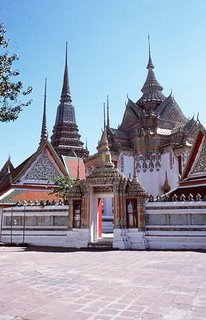 Massage - Wat Pho is also famous as Thailand's first university, and is center for traditional Thai masage - the rich, famous and powerful have all been known to come here. Inscribed on stone in the walls of Wat Pho are all that was known about Thai massage dating from the reign of King Rama III (most previous texts were lost when the Burmese destroyed Ayuthaya)
To get a traditional massage here costs 150B for 30 mins, 250B for an hour and herbal massages are available at 350B an hour. If you want to experience traditional Thai massage, this is probably the best place available and is highly recommended, though be aware that it's not exactly a gentle experience. A foot reflexology massage is also available at 250B for 45 minutes.
It is also possible to take courses to learn traditional Thai massage. These are for 30 hours and cost 4,500B. Courses can be spread over either 10 or 15 days. The massage center is situated at the back of the Wat, the opposite side from the entrance. To get a massage, simply turn up here and wait in line until a masseur is available - perhaps 10 or 20 minutes in the quieter periods in the early morning and late afternoon.
Massage - Wat Pho is also famous as Thailand's first university, and is center for traditional Thai masage - the rich, famous and powerful have all been known to come here. Inscribed on stone in the walls of Wat Pho are all that was known about Thai massage dating from the reign of King Rama III (most previous texts were lost when the Burmese destroyed Ayuthaya)
To get a traditional massage here costs 150B for 30 mins, 250B for an hour and herbal massages are available at 350B an hour. If you want to experience traditional Thai massage, this is probably the best place available and is highly recommended, though be aware that it's not exactly a gentle experience. A foot reflexology massage is also available at 250B for 45 minutes.
It is also possible to take courses to learn traditional Thai massage. These are for 30 hours and cost 4,500B. Courses can be spread over either 10 or 15 days. The massage center is situated at the back of the Wat, the opposite side from the entrance. To get a massage, simply turn up here and wait in line until a masseur is available - perhaps 10 or 20 minutes in the quieter periods in the early morning and late afternoon.
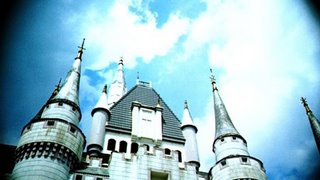 In the south of Tenerife, in the busier tourist region, you will find the area of the future Aquatic Park “SIAM PARK” This new project, being constructed by the Loro Park, S.A. group, will greatly increase the attraction of tourism and leisure to Tenerife. SIAM PARK will extend over an area of 185.000 square meters. Earth moving a planting work began at the beginning of 2004 creating an oasis to transport you through monuments, buildings, architecture and culture of the old kingdom of Siam(Bangkok), now known as Thailand. The attraction SIAM PARK will offer, have never before been in any other aquatic park in the world.
In the south of Tenerife, in the busier tourist region, you will find the area of the future Aquatic Park “SIAM PARK” This new project, being constructed by the Loro Park, S.A. group, will greatly increase the attraction of tourism and leisure to Tenerife. SIAM PARK will extend over an area of 185.000 square meters. Earth moving a planting work began at the beginning of 2004 creating an oasis to transport you through monuments, buildings, architecture and culture of the old kingdom of Siam(Bangkok), now known as Thailand. The attraction SIAM PARK will offer, have never before been in any other aquatic park in the world. 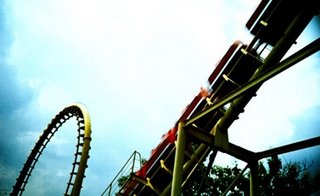 Siam Water Park is a huge entertainment complex northeast of the city, merely a 60-minute drive from the Lard Prao flyover, and is located in suburban Amphoe Minburi. The park features an extensive man-made sea with artificial surf, whirlpools, fountains and waterfalls, and towering water slides amid carefully landscaped gardens. Satellite attractions include children's playgrounds, aviaries, and open zoo and botanical gardens. About half of the complex is devoted for swimmers and the rest for a selection of rides and amusement games. Facilities include changing rooms, swimsuit rental, fast food and bus from entrance to water park. During holidays and festivals, the park hosts circus or similar entertainments.
Siam Water Park is a huge entertainment complex northeast of the city, merely a 60-minute drive from the Lard Prao flyover, and is located in suburban Amphoe Minburi. The park features an extensive man-made sea with artificial surf, whirlpools, fountains and waterfalls, and towering water slides amid carefully landscaped gardens. Satellite attractions include children's playgrounds, aviaries, and open zoo and botanical gardens. About half of the complex is devoted for swimmers and the rest for a selection of rides and amusement games. Facilities include changing rooms, swimsuit rental, fast food and bus from entrance to water park. During holidays and festivals, the park hosts circus or similar entertainments.
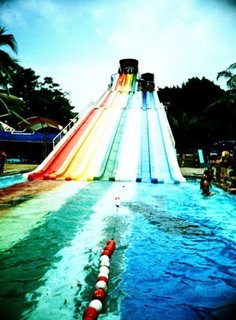 The complex is open daily from 10:00 A.M. to 6:00 P.M. (weekdays) and 9:00 A.M. to 7:00P.M. (weekends). Admission fee is 200 Baht for adults and 100 Baht for children. Membership fee is 300 Baht per year. Bus service: No. 26 and 27 from Victory Monument. Telephone - 5170075-9.
The complex is open daily from 10:00 A.M. to 6:00 P.M. (weekdays) and 9:00 A.M. to 7:00P.M. (weekends). Admission fee is 200 Baht for adults and 100 Baht for children. Membership fee is 300 Baht per year. Bus service: No. 26 and 27 from Victory Monument. Telephone - 5170075-9.

